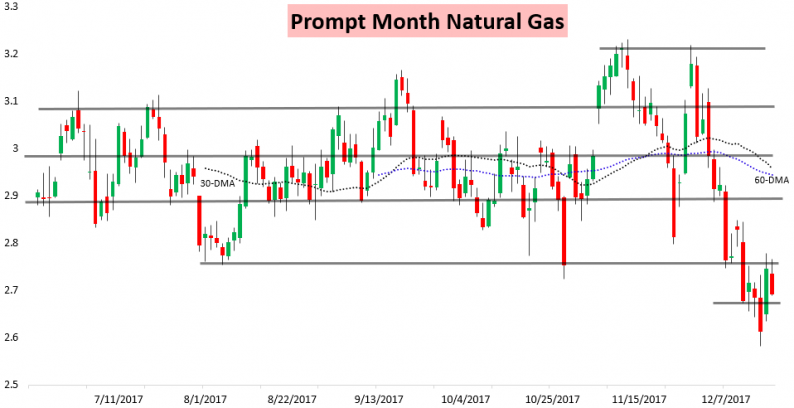Natural gas prices gave back some of their gains yesterday, but as is often the case losses were not uniform along the natural gas strip. We see that generally trading today was range-bound for the prompt month contract.

Yet today it was the February 2018 contract (G8) that saw the largest losses on the day, followed by the March 2018 contract (H8) and then the January prompt month contract (F8).

Such price action indicates that it was not as much balance that was driving prices lower but rather slightly less impressive weather expectations keeping prices below resistance, which is exactly what we warned our clients early this morning in our Morning Text Message Alert.

That does not tell the whole story, however. As cold approaches, traders are worried that cash prices will find a way to rally a bit more and prop up the front of the strip briefly, even in the face of recent production increases. This has caused the F/G spread to recover significantly.

Cash prices did show some strength today, potentially helping to explain that spread’s movement. Yet H/J sold off decently on the day today too, indicating that traders do not see much reason for the upcoming few winter months to be trading at much of a premium to the Spring 2018 contracts (and thus that bullish weather expectations in the short-term seemed to ease slightly).

The culprit seemed to be the afternoon 12z operational GFS weather model, which showed a large run-over-run flip warmer from its early morning 6z run and a far warmer flip from its overnight 0z run. This model timing coincided with the intraday selling we saw in natural gas prices, where H/J declined as well. Below we show the differences aloft in the 8-10 Day time period between the overnight 0z model run and the 12z model run, courtesy of the Penn State E-Wall.

As can clearly be seen, the model showed much less of a ridge across northwestern Canada and far less of a trough across the Ohio River Valley and Northeast that would deliver more cold at the surface. Yet even the model’s own 12z ensembles disagreed with it, favoring sustained cold still in the 8-14 Day time frame. There were some slightly warmer trends, but nothing like what was seen on the operational (model images again courtesy of the Penn State E-Wall).
















Leave A Comment